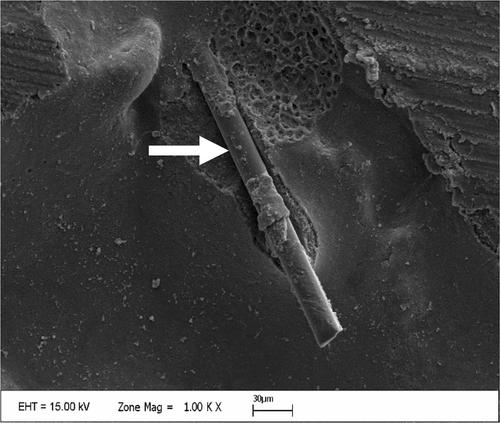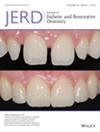Effects of different surface treatments on surface topography and bond strength in the repair of fiber-reinforced dentin composite
Abstract
Objective
This study aimed to evaluate the effects of different surface treatments on the repair bond strength between a fiber-reinforced dentin composite and a posterior composite.
Methods
Forty fiber-reinforced dentin composite resin blocks (4 mm × 4 mm × 4 mm) were separated into eight groups (n = 5) according to the surface preparation methods: (G1) negative control group, (G2) adhesive application, (G3) 50% dimethylsulfoxide (DMSO) application, (G4) 50% DMSO + adhesive application, (G5) 37% phosphoric acid etch + adhesive application, (G6) air abrasion + adhesive application, (G7) 37% phosphoric acid etch + 50% DMSO application + adhesive application, and (G8) air abrasion +50% DMSO application + adhesive application group. The composite surfaces were repaired in two layers with a posterior composite. Composite sticks were subjected to a micro tensile bond strength (μTBS) test. Fractured surfaces were evaluated using a stereomicroscope (×25). Short fiber-reinforced composite samples' surfaces were investigated by scanning electron microscope (SEM). Shapiro Wilk, one-way ANOVA, and Tukey HSD tests were used for statistical evaluation.
Results
The highest average (μTBS) values were observed in G8, whereas the lowest mean μTBS values were evident in the G1 group. Statistically significant μTBS values were found in all adhesive-applied groups when compared with the negative control group. Notably, the application of 50% DMSO without adhesive did not lead to a statistically significant increase in μTBS values. SEM images demonstrated that acid etching partially eliminated residues on the composite surface, while air abrasion had a detrimental effect on the integrity of fiber structures.
Conclusion
In the repair of fiber-reinforced dentin composite with a posterior composite, adhesive application is an effective approach. The treatment of 50% DMSO without adhesive did not confer a statistically significant advantage, and the supplemental use of acid etch or air abrasion did not show an additional benefit compared to adhesive-only repairs.
Clinical Significance
Adhesive application emerges as a potent and effective strategy for the repair of bur-roughened fiber-reinforced dentin composites. With its limitations, the study highlights the efficacy of adhesive-only repairs without the necessity for additional surface treatments.


 求助内容:
求助内容: 应助结果提醒方式:
应助结果提醒方式:


